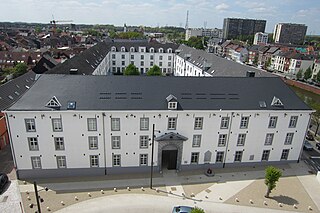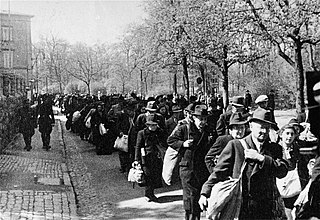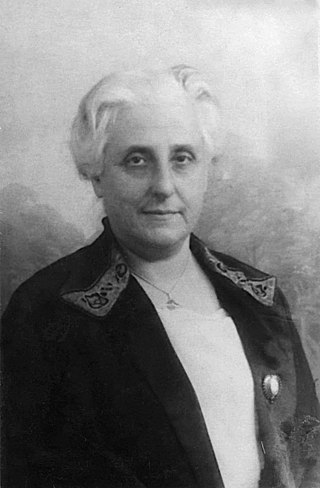
Camp Westerbork, also known as Westerbork transit camp, was a Nazi transit camp in the province of Drenthe in the Northeastern Netherlands, during World War II. It was located in the municipality of Westerbork, current-day Midden-Drenthe. Camp Westerbork was used as a staging location for sending Jews to concentration camps elsewhere.

Esther (Etty) Hillesum was the Dutch author of confessional letters and diaries which describe both her religious awakening and the persecutions of Jewish people in Amsterdam during the German occupation. In 1943, she was deported and murdered in Auschwitz concentration camp.
Villa Bouchina was the parsonage of the Christian Reformed Church in the City of Doetinchem, Province of Gelderland. From February 27 until April 21, 1943, it was used temporarily to house nine Jews, including three children, who were known as Mussert Jews.

Westerbork is a village in the municipality of Midden-Drenthe in the Netherlands. It is located in the middle of the eastern province of Drenthe. During World War II, the Westerbork transit camp was located near the village. The Westerbork Synthesis Radio Telescope and the Camp Westerbork Museum are now situated at the site.
Plan-Frederiks was a plan made up by the Dutch politicians K.J. Frederiks and J. van Dam that was meant to protect Jewish people in name of the German people during World War II.

The Dutch resistance to the Nazi occupation of the Netherlands during World War II can be mainly characterized as non-violent. The primary organizers were the Communist Party, churches, and independent groups. Over 300,000 people were hidden from German authorities in the autumn of 1944 by 60,000 to 200,000 illegal landlords and caretakers. These activities were tolerated knowingly by some one million people, including a few individuals among German occupiers and military.
The Henneicke Column was a group of Dutch Nazi collaborators working in the investigative division of the Central Bureau for Jewish Emigration, with headquarters in Amsterdam, during the Nazi Germany occupation of the Netherlands in World War II. Between March and October 1943 the group, led by former auto mechanic Wim Henneicke and Willem Briedé, was responsible for tracking down Jews in hiding and arresting them. The group arrested and "delivered" to the Nazi authorities 8,000-9,000 Jews. Most of them were deported to Westerbork concentration camp and later shipped to and murdered in Sobibor and other German extermination camps.

Kamp Amersfoort was a Nazi concentration camp near the city of Amersfoort, the Netherlands. The official name was "Polizeiliches Durchgangslager Amersfoort", P.D.A. or Amersfoort Police Transit Camp. 37,000 prisoners were held there between 1941 and 1945. The camp was situated in the northern part of the municipality of Leusden, on the municipal boundary between Leusden and Amersfoort in the central Netherlands.

Herzogenbusch was a Nazi concentration camp located in Vught near the town of 's-Hertogenbosch, Netherlands. The camp was opened in 1943 and held 31,000 prisoners. 749 prisoners died in the camp, and the others were transferred to other camps shortly before Herzogenbusch was liberated by the Allied Forces in 1944. After the war, the camp was used as a prison for Germans and for Dutch collaborators. Today there is a visitors' center which includes exhibitions and a memorial remembering the camp and its victims.

The Mechelen transit camp, officially SS-Sammellager Mecheln in German, also known as the Dossin barracks, was a detention and deportation camp established in a former army barracks at Mechelen in German-occupied Belgium. It served as a point to gather Belgian Jews and Romani ahead of their deportation to concentration and extermination camps in Eastern Europe during the Holocaust.

Abel Jacob Herzberg was a Dutch Jewish lawyer and writer, whose parents were Russian Jews who had come to the Netherlands from Lithuania. Herzberg was trained as a lawyer and began a legal practice in Amsterdam, and became known as a legal scholar also. He was a Zionist from an early age, and around the time of the outbreak of World War II he attempted to emigrate with his family to Palestine. During the war he remained active in Jewish organizations until he was interned, with his wife, in Bergen-Belsen concentration camp, where his legal background and status as a legal scholar earned him a seat on a prisoners' court. After their captors moved them from Bergen-Belsen, he and his wife were later liberated by the Soviets and made it back to the Netherlands, where they were reunited also with their children. He continued his legal practice in Amsterdam, though he traveled to Palestine and was offered an administrative position in newly-founded Israel.
The Saved is a Dutch documentary released in 1998. It was directed by Paul Cohen and Oeke Hoogendijk.

Eduard Maurits Meijers was a Dutch jurist of Jewish background, who was the founding father of the current Dutch civil code, the Nieuw Burgerlijk Wetboek.

Abraham Asscher was a Dutch Jewish businessman from Amsterdam, a politician, and a leader of his community who attained notoriety for his role during the German occupation of the Netherlands (1940–1945).

Henri Polak was a Dutch trade unionist and politician. Polak is best remembered as a longtime president of the General Diamond Workers' Union of the Netherlands (ANDB) and as a founder of the Dutch Social Democratic Workers' Party in 1894. Targeted as a Jew, a socialist, and a trade unionist, Polak was arrested by the Nazis in 1940 but died early in 1943 before he could be deported.

The Holocaust in the Netherlands was part of the European-wide Holocaust organized by Nazi Germany and took place in the German-occupied Netherlands. In 1939, there were some 140,000 Dutch Jews living in the Netherlands, among them some 24,000 to 25,000 German-Jewish refugees who had fled from Germany in the 1930s..

Bertha "Betsy" Bakker-Nort was a Dutch lawyer and politician who served as a member of the House of Representatives for the Free-thinking Democratic League (VDB) from 1922 to 1942.

The question of how much Germans knew about the Holocaust while it was ongoing continues to be debated by historians. With regards to Nazi Germany, some historians argue that it was an open secret amongst the population, whilst others highlight a possibility that the German population were genuinely unaware of the Final Solution. Peter Longerich argues that the Holocaust was an "open secret" by early 1943, but some authors place it even earlier. However, after the war, many Germans claimed that they were ignorant of the crimes perpetrated by the Nazi regime, often using the stereotypical phrase "Davon haben wir nichts gewusst".

Kurt Schlesinger was a German Jewish administrative director of Westerbork transit camp during World War II.

Hendrika Wilhelmina Bernardina "Mien" van Itallie-van Embden was a Dutch lawyer and politician who served as a member of the House of Representatives from 1928 until 1933 for the Free-thinking Democratic League (VDB).


















